The purpose of this website: helping you learn to play the piano. Building a strong foundation of piano-playing skills will lead to a lifetime of piano-playing joy.
"Pre"-Lesson 1
Piano Fingering, Piano Technique, and Piano Posture: Laying the Foundation
Piano Fingering
The finger numbers for piano are simple. Learn them, remember them, and make them automatic so you don’t have to stop and think about which finger is which.
- -Finger #1: thumb
- -Finger #2: index finger
- -Finger #3: middle finger
- -Finger #4: ring finger
- -Finger #5: pinky

Develop your piano fingering proficiency by learning many of the songs found in free piano lessons , as well as learning and mastering the piano scales.
For a more complete understanding of how to build your piano-playing foundation, read
For the most direct, organized, and progressive path to learning to play the piano, start
the Piano Skills Foundation series of piano lessons.
(Advertisement)
Along with piano fingering:
hand position and piano technique
Your thumb and pinky will naturally tend to play flat, but if you keep them tall (as if “diving” into the keys) you will develop a stronger technique. Play with firm, curved fingers (use the natural curve of your fingers, not over-curved and not flat), but keep your arms and shoulders loose.
Here are a couple examples of good hand position:
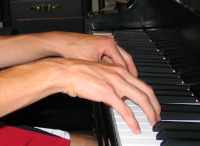
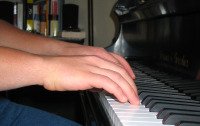
As you play each note, you should feel the weight of your arm dropping, or pouring, into the key-bed through your fingers. You will find more freedom in your playing if you learn how to use the weight of your arms, rather than tensing and pushing on the keys.
Learning piano fingering and developing a good piano technique are basic to playing the piano, but it all starts with how you sit at the piano. Your position in relation to the keys, your balance, your piano posture… all will have either positive or negative effects on your playing. Here are the basics:
Sitting At The Piano
For a very natural and effective piano posture, sit on the front half of the bench, with your feet firmly on the floor. (Your feet will be your balance as you need your hands for playing.)
When you place your hands on the keys, your elbows should be slightly in front of you. If your elbows are directly to your side, or behind you, the bench is too close to the keys. If your arms are stretched out, you are too far from the keys.
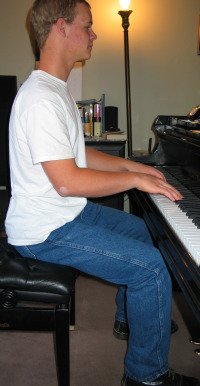
Sit tall (no slouching), in front of middle-C (see keyboard diagram). When you play the piano, lean slightly forward (try not to lean backward). Relax your arms and shoulders as you hold your hands over the keys.
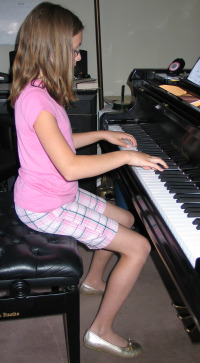
Ideally, your piano bench is set at a height which allows your arms to be level, or sloping slightly down, as you place your hands in position on the keys. This allows you to use your upper body weight more easily as you play the piano.
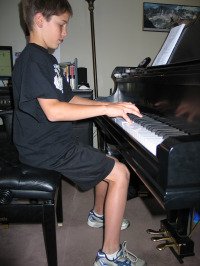
These are some students of mine. Don't they look so happy! Of course, they naturally sit with the best posture at all times at the piano. (Especially when the teacher nags incessantly, threatening to make them play scales and exercises until they comply and sit the right way.)
Seriously, though, the way a piano player sits at the piano has a lot to do with how well their piano technique develops. It should feel natural and fairly relaxed, with stability provided by the feet and the weight of the arms flowing freely into the keys.
Watch The Video
-click here for Wikipedia's discussion about fingering (interesting)-

If you want to see a blueprint for a successful piano journey...
read
"Piano Player... You"
A guide to building a solid and complete piano-playing foundation.
-Click here to learn more about this e-book-
If you would like a step-by-step guide to help you on your piano journey...
start working through
"The Piano Skills Foundation" piano lessons
-Click here to learn more about this piano course-
return from "Piano Fingering" to "Free Piano Lessons"
Looking for some piano music?
I have found Sheet Music Plus to be a fantastic resource for piano books & other materials. And they have instant digital downloads for thousands of individual pieces.
3 Ways To Support This Website
If you enjoy using true-piano-lessons.com and would like to help support it:
1. Buy the ebook, "Piano Player... You"
2. Purchase "Piano Skills Foundation"
3.Donation
